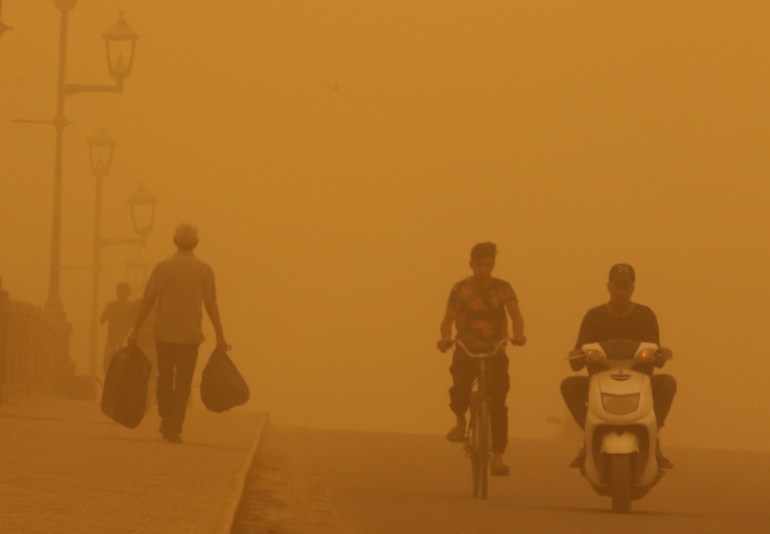A strong sandstorm caused - in Iraq today, Monday - the closure of many schools, universities and offices, and the suspension of flights at Baghdad, Najaf and Sulaymaniyah airports, in the latest storm in a series that Iraqis say has hit the country an unprecedented number in the past few weeks.
The displaced people living in tents in the north and west of the country are the most affected.
The authorities in Baghdad, including the Ministry of Education, declared a day off for local government institutions, except for security and health services.
Medical officials said hundreds of citizens across the capital and southern cities had gone to hospitals because of their breathing difficulties.
And Baghdad International Airport said - in a statement - that it will close its airspace and suspend all flights until further notice due to low visibility.
On Monday morning, layers of yellow sand covered buildings, cars parked in the streets and furniture of homes, while thick clouds of dust obscured view just a few meters.
At least one sandstorm has hit Iraq every week over the past few weeks, and Iraqis said it was the worst such wave in recent memory.
The current storm is the eighth since mid-April last, while in the last two months, dust storms have been unprecedented in Iraq, and experts attribute them to climate change, lack of rain and desertification.
Today, Monday, the Iraqi Ministry of Health announced the registration of more than two thousand cases of suffocation due to the dust storm, at a time when the ministry mobilized its efforts to deal with emergency cases.
"Health institutions are mobilized by their efforts to provide health services in health departments and hospitals," said the ministry's spokesman, Saif Al-Badr.
He called on Iraqis to "wear a mask and stay at home as much as possible, especially those who suffer from asthma and heart failure," stressing the need to "wear protective clothing and glasses when going out."
The situation of the displaced
Meanwhile, the situation of the displaced who have been in the camps for nearly 8 years has worsened.
Iraqi journalists and activists pointed out, through their accounts on the platforms, that the camps for the displaced are the most prominent areas affected by the dust storm, due to the accumulation of families inside tents that cannot protect those inside from entering the dust during the storm that has continued since last Sunday night.
If the residents of cities and those inside their homes suffocated from the severity of the dust storm that hits most of the cities of #Iraq, how will the situation be in the camps for the displaced?
What reality are they living in the meantime?
Who thinks of them from the politicians of the component or others?
God is enough, and yes, the agent
- Iyad Al-Dulaimi (@iyad732) May 16, 2022
Journalist Iyad Al-Dulaimi said - via his Twitter account - "If the residents of cities and those inside their homes suffocated from the severity of the dust storm that hits most of Iraq's cities, you see what the situation will be in the camps for the displaced, any reality they live in in the meantime, who thinks of them from Component politicians or others?"
Leadership is what you don't do to bring this child back to his home, and save him from the hell of the camps, which is not worth a quarter of a dinar....
pic.twitter.com/xjpNUNUJz1
- Firas Elias (@FirasEliasM) May 16, 2022
Political researcher Firas Elias commented - via his Twitter account - saying that "leadership that cannot return the displaced child to his home, and rid him of the hell of the camps, is not worth a quarter of a dinar," in reference to political leadership.
The conditions of the Sunni Arabs in #Iraq from the people of the Jurf al-Sakhar area and the rest of the western and northern cities who live in camps for the displaced during the frequent dust storms that have hit the country for weeks.
pic.twitter.com/eSvgCBBez1
— Mustafa Kamel (@mustafakamilm) May 16, 2022
Journalist Mustafa Kamel published a video clip - on his Twitter account - of a camp for displaced people in Anbar Governorate, commenting on it, saying, "The conditions of the sons of... Iraq from the people of Jurf al-Sakhar and the rest of the western and northern cities residing in the camps for the displaced during the repeated dust storms that have struck the country for weeks."
The dust storm increases pain and adds very tragic conditions in the displacement camps that embrace the people of # Jurf_al -Sakhar
God suffices us and He is the best agent pic.twitter.com/rD4w0YyLP8
— Sabeeh Al-Kishtaini (@sabeeh_bkc) May 16, 2022
Journalist Sobeih Al-Qashtini wrote - on his Twitter account - that "the dust storm increases pain and adds very tragic conditions in the displacement camps that embrace the people of Jurf al-Sakhar."
The United Nations says that Iraq is the fifth most exposed country in the world to the risks of the climate crisis and desertification, especially due to the increasing drought with high temperatures that exceed 50 degrees Celsius for days in the summer.
And the Director General of the Technical Department of the Iraqi Ministry of Environment warned - in an interview with the Iraqi News Agency - of the increase in sandstorms, especially after the number of dusty days rose to "272 days per year for a period of two decades."
And it is likely that "it will reach 300 dusty days per year in 2050."

